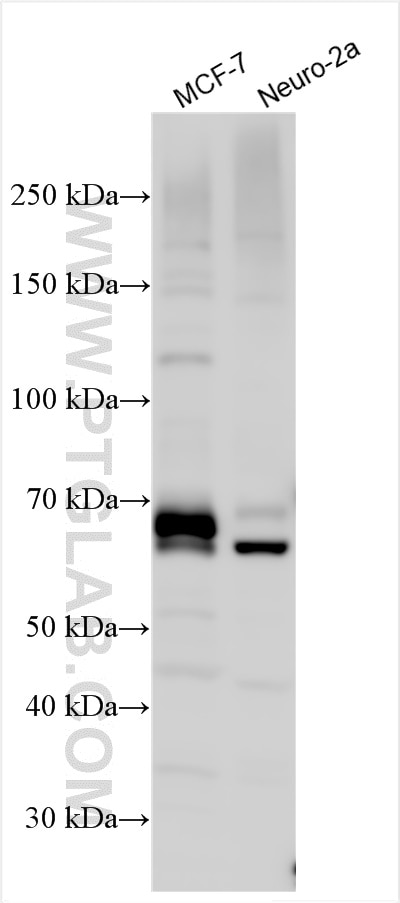Validation Data Gallery
Tested Applications
| Positive WB detected in | MCF-7 cells, Neuro-2a cells |
Recommended dilution
| Application | Dilution |
|---|---|
| Western Blot (WB) | WB : 1:500-1:3000 |
| It is recommended that this reagent should be titrated in each testing system to obtain optimal results. | |
| Sample-dependent, Check data in validation data gallery. | |
Product Information
28496-1-AP targets MTMR14 in WB, ELISA applications and shows reactivity with Human, mouse samples.
| Tested Reactivity | Human, mouse |
| Host / Isotype | Rabbit / IgG |
| Class | Polyclonal |
| Type | Antibody |
| Immunogen |
CatNo: Ag29627 Product name: Recombinant human MTMR14 protein Source: e coli.-derived, PET28a Tag: 6*His Domain: 15-240 aa of BC050626 Sequence: SSASSGNQPPQELGLGELLEEFSRTQYRAKDGSGTGGSKVERIEKRCLELFGRDYCFSVIPNTNGDICGHYPRHIVFLEYESSEKEKDTFESTVQVSKLQDLIHRSKMARCRGRFVCPVILFKGKHICRSATLAGWGELYGRSGYNYFFSGGADDAWADVEDVTEEDCALRSGDTHLFDKVRGYDIKLLRYLSVKYICDLMVENKKVKFGMNVTSSEKVDKAQRYA 相同性解析による交差性が予測される生物種 |
| Full Name | myotubularin related protein 14 |
| Calculated molecular weight | 72 kDa |
| Observed molecular weight | 60-72 kDa |
| GenBank accession number | BC050626 |
| Gene Symbol | MTMR14 |
| Gene ID (NCBI) | 64419 |
| RRID | AB_3086057 |
| Conjugate | Unconjugated |
| Form | |
| Form | Liquid |
| Purification Method | Antigen affinity purification |
| UNIPROT ID | Q8NCE2 |
| Storage Buffer | PBS with 0.02% sodium azide and 50% glycerol{{ptg:BufferTemp}}7.3 |
| Storage Conditions | Store at -20°C. Stable for one year after shipment. Aliquoting is unnecessary for -20oC storage. |
Background Information
MTMR14, also known as Jumpy, belongs to the MTM1/MTMRs family which has 15 members that divided into two subgroup: catalytically inactive and active. MTMR14 is a catalytically active member possessing an active phosphatase domain, that specifically dephosphorylates PI3P and phosphatidylinositol (3,5)-bisphosphate (PI3,5P2) at position 3 on inositol ring. A remarkable feature of the MTM1/MTMRs family is the association between a catalytically inactive member and a catalytically active member, which plays an important regulatory role. MTMR14 has 3 isoforms with molecular weight of 60-72 kDa, and also can be detected as a higher molecular weight due to the heterodimerization with other MTMR members.
Protocols
| Product Specific Protocols | |
|---|---|
| WB protocol for MTMR14 antibody 28496-1-AP | Download protocol |
| Standard Protocols | |
|---|---|
| Click here to view our Standard Protocols |

